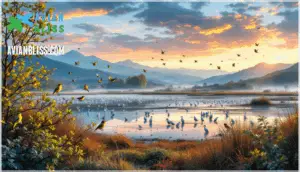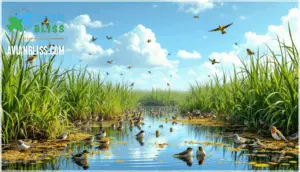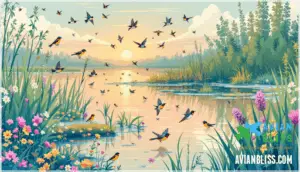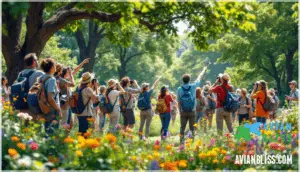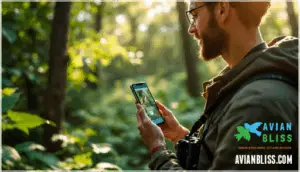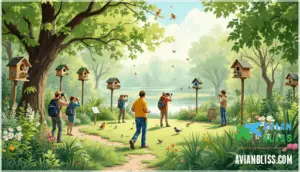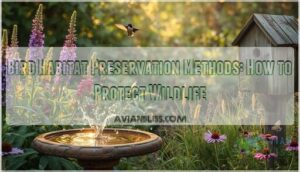This site is supported by our readers. We may earn a commission, at no cost to you, if you purchase through links.
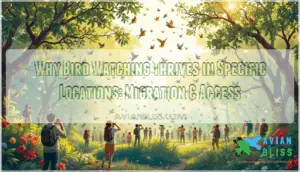
The answer to why there are such singular places for bird watching lies in the invisible architecture of migration routes, the fragmented geography of suitable habitat, and the communities that form around these concentrated natural spectacles. Understanding what draws birds to specific stopover sites, how urban green spaces create unexpected oases, and why accessibility transforms good birding spots into great ones reveals the intricate relationship between avian biology, landscape design, and human connection to the natural world.
Table Of Contents
- Key Takeaways
- Birds in Urban Landscapes
- Bird Migration Patterns
- Community Engagement and Birding
- Accessibility in Birding Spots
- Technology and Birding
- Conservation Efforts and Birding
- Frequently Asked Questions (FAQs)
- Why do people enjoy birdwatching?
- Why is bird watching a fun activity?
- What can I do if I’m interested in birdwatching?
- Why are urban and suburban bird-watching structures important?
- What is the proper term for bird watching?
- What’s the difference between birding and bird watching?
- What is the nickname for a bird watcher?
- What is the hobby of bird watching called?
- What attracts birds to backyard feeders?
- How do birds communicate with each other?
- Conclusion
Key Takeaways
- Certain locations become birding hotspots because migration routes funnel millions of birds through specific corridors, creating predictable concentrations where stopover habitats offer essential food, water, and shelter for refueling during long journeys.
- Urban green spaces function as critical ecological oases within fragmented landscapes, transforming parks, backyards, and even rooftop gardens into accessible birding destinations that support surprising avian diversity despite surrounding development.
- Community engagement amplifies birding experiences through organized field trips, citizen science projects like eBird, and local Audubon chapters that connect enthusiasts while contributing valuable data to conservation efforts and scientific research.
- Accessibility features including paved trails, wheelchair-friendly boardwalks, nearby parking, and crowd-sourced resources like Birdability transform good birding locations into exceptional ones by ensuring people of all abilities can participate in observation and conservation.
Birds in Urban Landscapes
You might think cities are the last place to spot interesting birds, but urban landscapes actually host surprising avian diversity.
From your own backyard to green spaces woven throughout the city, you’ll find accessible opportunities to observe birds without venturing far from home.
Here’s where urban bird watching happens most often.
Urbanization and Bird Habitats
As cities expand and reshape the landscape, you might expect birds to vanish—but many species have turned pavement and high-rises into surprisingly functional homes. Urban sprawl creates habitat fragmentation, yet green infrastructure—parks, green spaces, and vegetated corridors—provides critical refuges for urban birding.
While light pollution and noise pollution challenge avian populations, particularly during bird migration, adaptable species exploit these transformed bird habitats. Wildlife conservation efforts increasingly recognize cities as functional ecosystems where green spaces sustain biodiversity despite ongoing urbanization pressures.
Backyard Birdwatching and Accessibility
You don’t need to travel far to enjoy outstanding bird watching—your backyard offers immediate access to avian diversity with minimal equipment and no time constraints. Strategic feeder placement near native plants creates functional habitats that attract diverse species, while water sources provide critical resources. This accessible hobby transforms your property into a birding sanctuary where you can practice bird identification and contribute to nature observation.
Essential backyard birding practices:
- Position feeders with safety measures that prevent window collisions
- Establish nesting habitats using native vegetation
- Document observations for citizen science initiatives
Local Parks and Green Spaces for Birding
Local parks and green spaces function as ecological corridors within urban matrices, concentrating avian populations where habitat fragmentation would otherwise limit species diversity. These urban sanctuaries support bird diversity through varied park habitats—woodlands, wetlands, and meadows—that serve as birding hotspots for nature observation.
You’ll discover resident and migratory species in these green spaces, where local conservation efforts create accessible urban birding opportunities that connect communities with avian life.
Balconies and Rooftop Gardens as Birding Spots
While urban parks offer structured green spaces for observation, your own elevated outdoor space—whether a narrow balcony or expansive rooftop garden—can serve as an intimate avian monitoring station that brings bird diversity directly to your doorstep. These urban sanctuaries transform into functional rooftop ecosystems when you establish container habitats with native flowering plants, which provide nectar sources and nesting materials. Garden feeders and balcony birdhouses attract diverse bird species, allowing you to document bird conduct patterns while contributing to habitat preservation through urban birding practices. You’re creating microhabitats that support avian populations amid concrete landscapes.
Give your elevated birding station a boost:
- Position feeders near protective cover, allowing birds quick escape routes from potential predators
- Select native plant species that produce seeds, berries, or attract insects throughout seasonal cycles
- Install shallow water features, maintaining depths under two inches for safe bathing and drinking
- Document species observations through photography, contributing valuable data to citizen science initiatives
Bird Migration Patterns
Bird migration represents one of nature’s most striking phenomena, and understanding these patterns can transform your birding experience. Throughout the year, billions of birds travel along predictable routes, stopping at critical locations to rest and refuel.
Let’s explore the key factors that drive bird migration and why certain spots become birding hotspots during specific seasons.
Seasonal Changes and Bird Movement
Each spring and fall, billions of birds traverse entire continents, driven by an ancient biological clock that acknowledges shifting daylight and temperature cues. You’ll notice different bird species timed precisely to breeding seasons, when resource availability peaks at their destinations.
Migrations align with molting patterns, guaranteeing birds are flight-ready before departing winter habitats. These movements transform remote locations into birding hotspots, where you can witness striking shifts in bird activity as populations ebb and flow with the seasons.
Flyways and Migration Routes
Across continents, birds follow well-defined migration highways called flyways—critical corridors connecting breeding grounds with wintering habitats. You’ll find nine major global flyways guiding more than 2,000 bird species, with the African-Eurasian flyway alone covering 500+ species across 100 countries. These routes face mounting migration threats, from habitat loss to climate-driven shifts in stopover timing. Six of these are marine flyways, essential for migratory seabirds.
- Route distances: Bar-tailed Godwits and Red Knots travel thousands of kilometers between Siberian Arctic and West Africa.
- Population trends: Along the East Atlantic Flyway, 33% of assessed populations are declining, while monitoring advances through tools like eBird and BirdCast help track real-time movements for flyway conservation efforts.
Understanding these pathways reveals why certain birding hotspots attract diverse bird species during peak migrations.
Stopover Points and Refueling Stations
During migrations, bird species depend on stopover points—critical refueling stations where they rebuild fat reserves after depleting energy stores. These sites account for nearly two-thirds of total energy expenditure along migration corridors, making refueling rates essential for survival and reproductive success. Habitat loss threatens these oases, driving conservation priorities focused on preserving stopover networks. Understanding a bird’s fuel index upon arrival is an important predictor of stopover duration.
You’ll find hotspots concentrated near coastlines, major rivers, and forested patches, where energetic demands meet food availability, shaping bird actions and migration success.
| Stopover Feature | Impact on Bird Watching |
|---|---|
| Refueling duration | Longer stays increase observation opportunities for multiple bird species |
| Habitat quality | High-quality sites attract diverse migrants, enhancing birding experiences |
| Seasonal timing | Spring and fall peaks create predictable windows for targeted bird watching |
Habitat Requirements for Migrating Birds
Migrating birds require a precise combination of food abundance, water access, and protective cover—without these elements, even short-distance travelers can’t complete their journeys. Climate resilience determines whether avian ecology adapts or collapses. You’ll support migrations by prioritizing habitat preservation:
- Food availability: Insects, seeds, and nectar sustain energy-depleted travelers
- Water sources: Hydration and bathing maintain flight-ready plumage
- Shelter needs: Dense vegetation provides nesting sites and protection from predators
Ecological landscapes depend on maintaining this ecological balance.
Community Engagement and Birding
Bird watching isn’t just a solo pursuit—it’s a hobby that brings people together in meaningful ways. Whether you’re attending organized events, connecting with fellow birders online, or contributing to important research, community involvement can transform your birding experience.
Here are some of the most rewarding ways you can engage with the birding community and deepen your connection to the natural world.
Local Audubon Chapters and Field Trips
If you’ve ever wondered where the quiet thrill of birding meets the warmth of shared discovery, local Audubon chapters provide that bridge, organizing field trips that turn solitary observation into collective adventure. These excursions offer expert-led guidance through diverse habitats, helping you sharpen identification skills while contributing to conservation initiatives. Whether you’re tracking migratory warblers or documenting breeding populations, the Audubon Society connects outdoor enthusiasts through structured nature outings that build lasting birding relationships.
| What You’ll Find | Why It Matters |
|---|---|
| Chapter Activities | Scheduled outings target seasonal migrations and local hotspots |
| Trip Logistics | Transportation, timing, and accessibility details addressed upfront |
| Skill Development | Field experts teach call recognition and behavioral observation |
| Conservation Focus | Your sightings contribute to habitat protection data |
| Community Building | Bird watching transforms from solo pursuit to shared passion |
Birding Festivals and Events
Birding festivals transform regional flyways into celebration hubs, where thousands of enthusiasts gather to witness peak migration spectacles while connecting with researchers, photographers, and conservation leaders. These events blend festival tourism with hands-on bird watching experiences, offering:
- Educational workshops on call identification and habitat ecology
- Guided field trips to prime stopover sites during peak migration
- Photo competitions celebrating avian diversity and conservation focus
- Expert panels discussing climate impacts on birding communities and networking
- Vendor booths featuring optics, field guides, and event accessibility resources
You’ll find community building happens naturally when shared passion meets structured discovery.
Online Forums and Social Media Groups for Birders
Digital platforms have revolutionized how birders share real-time sightings, troubleshoot identification challenges, and coordinate field excursions across continents. You’ll discover birding communities and networking opportunities through platforms where bird enthusiasts exchange online ID expertise while practicing forum etiquette. These spaces thrive when:
- Species identification queries receive expert guidance from experienced bird watchers.
- Group moderation maintains accuracy, minimizing misinformation spread.
- Local birding hotspots and conservation updates foster genuine connection.
Citizen Science Projects and Community Involvement
You can strengthen your birding skills while advancing bird conservation efforts through citizen science projects that welcome all experience levels. Platforms like eBird collect millions of annual observations across more than 100 countries, and data validation tools guarantee your sightings inform habitat preservation decisions and climate impact assessments.
Project participation transforms your field notes into scientific datasets tracking bird species distribution, migration timing, and population trends within birding communities nationwide.
Educational outreach through programs like the Great Backyard Bird Count—which documented nearly 7,000 species globally—pairs tech accessibility with conservation impact, turning everyday birders into essential contributors to our understanding of avian ecology.
Accessibility in Birding Spots
Not every birding spot is created equal in terms of welcoming everyone outdoors. Accessibility features like paved paths, nearby parking, and thoughtful amenities can make or break the experience for birders with mobility challenges or other needs.
Here’s what to look for when seeking out birding locations that truly open the door to all.
Wheelchair-Accessible Trails and Boardwalks
Accessible birding infrastructure transforms natural spaces into welcoming environments where mobility limitations don’t prevent you from experiencing the rich diversity of avian life.
Wheelchair-accessible trails constructed with smooth, stable surfaces and boardwalks built from durable, slip-resistant materials create safe nature observation spaces for all abilities.
These bird watching stations feature accessible design elements like gentle grades, wide pathways, and inclusive signage that improve your birding experience while respecting the ecological landscape.
Birding Spots With Parking and Amenities
Once you’ve found an accessible trail that works for you, the next step is making sure you can actually get there—and that means parking, restrooms, and a few creature comforts that turn a quick outing into a full morning in the field.
Well-designed birding spots prioritize accessible parking near trailheads, restroom availability, and picnic areas where you can refuel between observations. Look for nature observation spaces that offer:
- Accessible parking with designated spaces close to bird watching stations.
- Restroom availability so you’re not cutting your birding short.
- Picnic areas where the bird watching community gathers and shares sightings.
- Shelter options for weather protection during extended observations.
- Trail conditions posted online or at kiosks for planning your visit.
These amenities transform casual outings into comfortable, extended field experiences.
Birdability Website and Crowd-Sourced Map
The Birdability website functions as a continuously updated repository of accessible birding locations, built by observers who understand that mobility shouldn’t limit your ability to document species in the field.
You’ll find crowd-sourced data accuracy verified through community feedback, with inclusivity metrics that detail accessibility features at bird watching stations nationwide.
The platform’s map updates reflect real-time conditions at nature observation spaces, so the bird watching community can plan visits with confidence.
Inclusive Birding Groups and Tours
When you join an inclusive birding group, you’re not just spotting species—you’re finding a community that treats access barriers like obstacles worth clearing together. These tours embody adaptive birding principles, offering nature enthusiasts:
- Sensory considerations for varied abilities
- Financial accessibility through subsidized trips
- Diverse leadership reflecting the bird watching community
- Welcoming spaces designed for ecotourism
- Wheelchair-friendly routes at observation sites
Your participation strengthens birding’s inclusive future.
Technology and Birding
Technology has transformed bird watching from a solitary pursuit into a connected, data-driven activity. Whether you’re using apps to identify unfamiliar calls or contributing sightings to global databases, digital tools have made birding more accessible and impactful.
Here’s how modern technology improves your time in the field.
Birding Apps and Identification Tools
If you’ve ever fumbled through a field guide while a mystery bird vanishes into the canopy, you’ll appreciate how apps like Merlin Bird ID have revolutionized species identification in real time. These tools use sound identification and photo analysis to match observations instantly, with offline use guaranteeing you’re covered in remote locations.
Technological advances in birding, from AR birding features to app accuracy improvements, make bird species identification accessible whether you’re tracking migrants or learning backyard species habits.
EBird and Citizen Science Projects
Every time you log a sighting on eBird, you’re feeding a living database that ornithologists and conservation biologists rely on to decode bird distribution patterns, population shifts, and habitat use across continents. Your observations strengthen data accuracy, revealing how bird species respond to habitat loss and climate change.
Citizen science projects thrive on volunteer motivation, transforming casual bird watching into conservation strategies that protect migrations worldwide. Here’s how your contributions make an impact:
- Track population trends across flyways and stopover sites
- Inform habitat preservation through data sharing with researchers
- Document rare species occurrences that shape project impacts
- Support real-time conservation decisions during critical breeding seasons
Camera Traps and Wildlife Photography
Camera traps let you witness avian activity without your presence altering a single feather ruffle, capturing moments that even the most patient observer would miss crouched behind a blind at dawn. Strategic trap camera placement near feeders or nesting sites yields wildlife activity insights that transform your understanding of bird activity patterns.
Ethical considerations matter—position equipment to avoid disturbance while guaranteeing equipment longevity through weatherproofing.
Image data analysis reveals nature photography gold: courtship displays, feeding sequences, and territorial interactions that deepen your connection to nature and wildlife in ways traditional bird watching simply can’t match.
Conservation Efforts and Birding
Bird watching isn’t just about spotting rare species—it’s about protecting the habitats that make those sightings possible in the first place. Your efforts as a birder can directly contribute to conservation work, whether you’re creating refuge in your own backyard or joining larger initiatives that address threats like habitat loss and climate change.
Let’s explore how birding and conservation go hand in hand, and what you can do to make a real difference.
Habitat Preservation and Restoration
Without habitat preservation and restoration, you’ll watch bird populations dwindle before your eyes—making these conservation efforts not just important, but essential to keeping the skies alive with wings.
Ecosystem recovery through sustainable practices creates key habitat connectivity, allowing migrations across ecological landscapes. Conservation easements protect remote locations where wildlife thrives, while species reintroduction programs breathe life back into depleted areas, giving you more birds to discover and cherish.
Bird-Friendly Gardens and Urban Planning
Your backyard can become an essential refuge for birds if you plant native species and design with their needs in mind—even small urban gardens make a real difference when habitat loss threatens their survival.
Consider these practical strategies for supporting urban birdwatching:
- Native Plantings provide food sources and shelter year-round.
- Water Features attract diverse species for drinking and bathing.
- Pesticide Reduction protects insect populations birds depend on.
- Green Roofs improve habitat connectivity across fragmented city birding landscapes.
Climate Change and Bird Migration Patterns
Rising global temperatures are rewriting the script for migratory birds, altering migration timing and route changes, and creating serious resource mismatches. North American migrants now arrive one to two days earlier per decade, yet spring green-up is outpacing their shifts by up to 14 days along some flyways—leaving birds struggling to find peak food when they need it most.
Physiological adaptations like smaller body mass and longer wingspans help some species cope with warming, but increased risks from shrinking stopover habitats and dwindling rainfall in tropical zones are pushing survival rates down, reshaping avian ecology in ways that demand urgent habitat preservation and informed conservation action.
Birds adapt through smaller bodies and longer wings, yet shrinking habitats and rainfall declines threaten survival, demanding urgent conservation action
Local Conservation Initiatives and Community Involvement
While climate shifts force birds to adapt on a continental scale, you can make a tangible difference right where you live by joining local conservation initiatives that protect critical habitats and strengthen bird populations in your own backyard.
Participate in habitat restoration projects, contribute to citizen monitoring programs like eBird, and engage in community education workshops that build awareness.
Your involvement in policy advocacy, paired with funding opportunities through local Audubon chapters, strengthens wildlife protection efforts and demonstrates the importance of conservation through meaningful community engagement and outreach.
Frequently Asked Questions (FAQs)
Why do people enjoy birdwatching?
Birdwatching offers stress reduction, nature connection, and the thrill of discovery. You’ll develop identification skills while observing bird habits and species diversity.
The social aspect fosters community, while benefits extend to mental well-being through mindful observation.
Why is bird watching a fun activity?
Like dialing up an old-fashioned party line, bird watching connects you to nature’s network. You’ll sharpen your identification skills, forge social connections through birding groups, and boost your mental wellbeing while appreciating nature’s diversity and observing fascinating bird actions outdoors.
What can I do if I’m interested in birdwatching?
Start birding by grabbing binoculars and a bird guide, then explore local parks.
Join birding groups to build ID skills, learn ethical birding practices, and connect with the community.
Bird watching as a hobby grows through consistent observation.
Why are urban and suburban bird-watching structures important?
Urban sanctuaries and nature observation spaces foster conservation awareness by making city birding accessible, strengthening human connection to wildlife.
These spaces promote ecological balance through thoughtful architectural design for wildlife in densely populated areas.
What is the proper term for bird watching?
The formal terminology encompasses both "birdwatching" and "birding," though ornithologists often distinguish between the two.
Birdwatching traditionally describes leisurely observation of avian species, while birding connotes more active pursuit, emphasizing identification skills and behavioral documentation that contribute to ornithology and citizen science initiatives.
What’s the difference between birding and bird watching?
Both terms describe observing birds, but birding usually implies a more active pursuit—seeking specific species, documenting sightings, and developing identification skills.
Bird watching suggests casual observation for enjoyment, requiring less intensive equipment or ornithological knowledge.
What is the nickname for a bird watcher?
In birding communities, you’ll hear enthusiasts called "twitchers"—a term originally describing those who’d drop everything to chase rare sightings.
More casual nicknames include "birder" for serious hobbyists or "bird nerd" for those deeply passionate about avian identification and ornithology slang within birding jargon circles.
What is the hobby of bird watching called?
The hobby is formally termed birding or bird watching, both widely recognized within ornithology and the broader bird-watching community.
Birding emphasizes the active pursuit of avian observation and bird identification, often involving citizen science contributions, while fostering connections among birding communities passionate about this enriching lifestyle.
What attracts birds to backyard feeders?
Think of feeders as roadside diners for birds—they stop by for the menu. Seed preferences, feeder types, and water sources draw diverse bird species.
Shelter availability and seasonal changes influence bird actions, making your yard a prime spot for bird watching and identification.
How do birds communicate with each other?
Vocalizations—from intricate songs to sharp alarm calls—dominate avian communication, with distinct Bird Calls signaling territory, courtship, or danger.
Visual displays, including plumage flashing and posturing, convey dominance or attraction, while tactile and chemical signals reinforce social bonds, shaping Bird Actions across diverse Bird Species and ecological contexts.
Conclusion
A songbird weighs less than an ounce, yet it navigates thousands of miles with precision, while you might drive past the perfect birding spot without noticing. That contrast explains why there is such a singular place for bird watching: geography, timing, and accessibility must align perfectly.
Migration routes funnel birds through specific corridors, stopover habitats concentrate them temporarily, and human infrastructure—trails, parking, community groups—transforms these natural convergences into accessible experiences. The warbler doesn’t choose Central Park randomly; it follows ancient pathways. Your choice to meet it there, binoculars ready, completes the connection these landscapes were built to make possible.
- https://www.fws.gov/story/threats-birds-collisions-nighttime-lighting
- https://www.theguardian.com/environment/2025/jan/18/country-diary-why-does-the-bird-bob-its-head
- https://www.wikihow.com/Bird-Symbolism
- https://www.seabirdtracking.org/special/marine-flyways/
- https://www.cost.eu/world-migratory-bird-day-euflynet/

